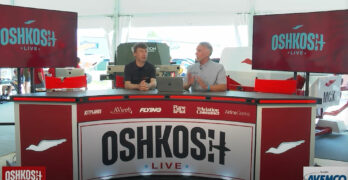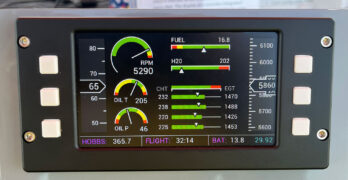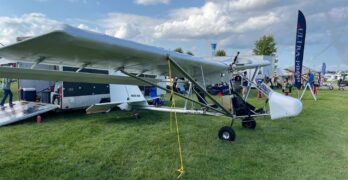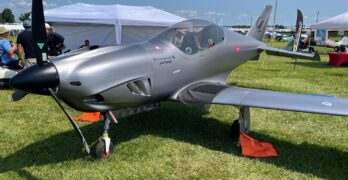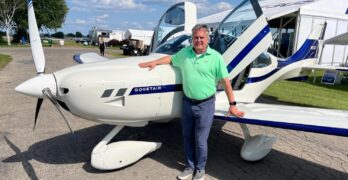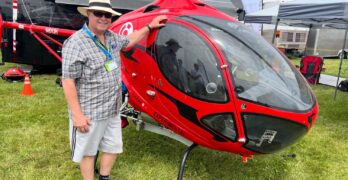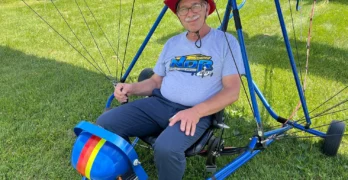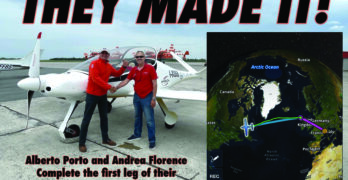As part of our parent company’s coverage of AirVenture this year, I had a chance to sit with several in the industry and talk about what’s happening generally and about new (and even re-emerging) technologies. One of those talks was with KITPLANES editor at large Paul Dye, who is working hard to educate pilots of LSA and homebuilt aircraft about the value of AoA and how easily it can be implemented with today’s instrument packages.
MOSAIC Next Steps—An Interview with Rian Johnson
As part of the Oshkosh Live streaming television the Firecrown aviation division (which includes this site as well as KITPLANES) did from AirVenture, I sat down with Rian Johnson, who is, in addition to his role as head of design engineering at Van’s Aircraft, the chair of the ASTM F37 committee working on MOSAIC industry-consensus standards. In this interview, he looks ahead at the next steps for MOSAIC and offers his perspective for what might come out of the FAA next year when the new rules package is announced.
Wapsi Aero Debuts Multifunction Display at AirVenture
If you are piloting an ultralight or light plane VFR, you really don’t need an artificial horizon or a heading indicator. But you do need airspeed and altitude, and it’d be nice to have that available in a compact, clear, modern package. Even better, you’d like to make sure everything is happy in the power barn, as well as your airspeed and altitude.
In the spirit of providing everything you need and nothing you don’t, Wapsi Aero brought a bright and affordable electronic flight instrument that has generated quite a bit of buzz at AirVenture’s ultralight field. The rectangular instrument provides graphical engine data mid screen with airspeed and altitude in legible tape readouts on each side—combining a partial EFIS with an engine monitor. The screen is bright and easily readable, even in direct sunlight. The instrument also provides Hobbs and flight timers as well as battery voltage.
Even better, the Wapsi device is designed to fit into the same hole that may currently house a GRT EIS engine monitor—of which there have to be thousands in the field.
Dragonfly Rancher Gets New Life in Florida
There is a two place tandem high wing light plane that looks a little like a single engine AirCam that has been knocking around for over a decade in, of all places, the hang gliding community. This sturdy craft, the Dragonfly Rancher, has been used to tow hang gliders to altitude without the necessity of plunging off a cliff. Developed by Bobby Bailey in the 80s, the Dragonfly earned its position as the premier hang glider tower when Bill Moyes invented a reliable and effective release mechanism for towing use.
The Dragonfly Rancher has also been put to agricultural use, as a ranch surveyor and even a spot sprayer. This workhorse has had almost a cult following, with many pilots taking advantage of its beefy construction to perform impressive aerobatics on YouTube. It is designed to take +6 to -2 Gs.
The Dragonfly Rancher design was owned by Pittman Air, LLC.
Blackshape Prime Veloce: Speeding at Mach 2 Standing Still
There are a lot of sexy looking airplanes displayed at AirVenture, but a sure front runner for sleekest looking plane around is the Prime Veloce all-composite, two-place tandem retractable sport plane from Monopoli, Italy. This little speedster is powered by a Rotax 915 iS and is listed as capable of a 170 knot cruise speed. It stalls at 45 knots with full flaps and 57 knots clean.
There are about 70 Prime Veloce aircraft flying in the rest of the world and Blackshape Aircraft, out of Sheridan, Indiana, will be importing them to the U.S. They are hoping to market the Prime Veloce as a completed aircraft, counting on MOSAIC regulations to empower them to accomplish that task. This “mosaic-ready” aircraft will carry 26 gallons of fuel and should be capable of 1,650 feet per minute climb at maximum takeoff weight. Blackshape will list the aircraft, depending on configuration at about $330,000.
Scissortail Aerosport Unveils Two-Place “MOSAIC-Ready” Gogetair G-750 At AirVenture
Scissortail Aerosport company, out of Tulsa, Oklahoma, imports sleek composite aircraft from Slovenia. Last year, they brought a sleek four place low wing to AirVenture that was well-received. This year, they imported an even sleeker and, dare we say, sexier looking, two place speedster that promises to be “Mosaic ready.” Named the GOGETAIR G-750, this little sportster trues out at 138 knots at 10,000 feet and stalls at 54 knots.
The two place Gogetair G-750 that Scissortail brought to AirVenture flies behind a Rotax 914 Turbo and a Woodcomp electric variable-pitch prop. Scissortail’s President, Shannon Hankins, states that the customer can also order a Rotax 915 and a hydraulically powered MT constant speed prop. The panel wears a Dynon HDX EFIS, but can be ordered with the Garmin G3X. This design features a fuselage roll safety cage and a whole airframe parachute. The Gogetair G-750’s most attractive trait, however is it’s eye-catching design, sporting swept wing tips and gull wing doors.
Cicaré 8 Kit Helicopter Debuts at AirVenture
It is hard to miss the sexy, sleek, Ferrari-red two-place helicopter on the Ultralight field at AirVenture. It’s new, it’s beautiful, and, as it turns out, it is a kit which can be completed in 200 hours, or even faster at a Cicaré builder assist facility. The two-place Cicaré 8 helicopter is appearing at AirVenture for the first time, made possible by Keith Barr, the President and CEO of the newly formed Cicaré USA corporation.
If the Cicaré name rings a bell, it is because of Augusto Cicaré, who moved from Italy to Argentina at age 19 to start and build what is now the storied Cicaré Helicopter Company. Cicaré has been designing and building helicopters for the Argentinian civilian and military since the early 1960s. Although Augusto died in January of 2022, his sons have continued the business, with great success.
The two place side by side Cicaré 8 was designed in Argentina in 2015.
Forty-Year-Old Ultralight Still Flying At AirVenture
At the 1993 EAA annual convention (long before they called it AirVenture) a young dreamer walked the ultralight grounds with hopes of someday building and flying an ultralight aircraft. On row 1 in front of the Ultralight Barn, Mike Ostrander spotted a well worn Quicksilver MX with a for sale sign. A short negotiation later, Mike, was the proud owner of an ultralight rebuild project. With the help of his father, he disassembled the Quick and brought it home to commence the resurrection. He also built a trailer for the Quick with the intention of avoiding hangar fees.
Mike’s yearlong restoration and construction efforts paid off when he brought his Quicksilver to Oshkosh in 1994. He brought home an honorable mention award in the ultralight category. On top of that, he won the EAA 1997 Reserve Grand Champion and another honorable mention in 2004. On the ultralight flight line at AirVenture this year, the Quicksilver still looks as new as the day he finished its restoration in 1994.
Risen Completes Transatlantic Leg
On June 14, a Porto Aviation’s Risen completed the transatlantic leg of its journey from Milan, Italy, to Oshkosh, Wisconsin. The company posted on social media: “We made it!!! I have been reluctant to post anything here before accomplishing this epic flight , being Italian I guess makes me more superstitious.A page in aviation history has been written by Alberto Porto and Andrea Florence (Venturini). 1900 nautical miles, average speed [of] 165 kts, with just over 43 gallons of fuel!!! We left this morning early in rainy Scotland and landed in the afternoon at Goose Bay the same day without refueling.”
The company announced its cross-the-pond plans this May to bring the newly re-engined Risen to the U.S. While many versions of the retractable-gear Risen use the Rotax 912, the company had been fitting the turbocharged 915 iS. But this example has the newer, more powerful Rotax 916 iS.



